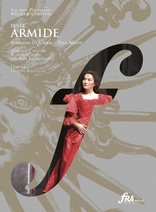
The original title: Jean-Baptiste Lully (1632-1687) - Armide
Outpu: 2011
Genre: Classical, Opera, Baroque
Director: Robert Carsen
Performers: Stéphanie D’Oustrac - Armide, Paul Agnew - Renaud, Claire Debono - La Gloire, Phénice, Lucinde, Isabelle Druet - La Sagesse, Sidonie, Mélisse, Nathan Berg - Hidraot, Marc Mauillon - Ubalde Aronte, Marc Callaghan - Artémidore, Andrew Tortise - Le Chevalier Danois, Laurent Naouri - La Haine, Anders J. Dahlin - Un Amant fortuné, Chœur et Orchestre Les Arts Florissants, William Christie
• For any enthusiast of Baroque music, the production of Lully's Armide at the Theatre des Champs Elysées, directed by William Christie and staged by Robert Carsen, was an exceptional event. The last and most successful collaboration between Lully and his librettist Quinault, Armide is the ideal of the genre as desired by Louis XIV: a tragic opera that achieves the perfect fusion of music, song and dance. William Christie leads the orchestra and chorus of Les Arts Florissants and a dazzling cast. Stephanie D'Oustrac is the imperious sorceress Armida, overcome by the violence of a forbidden passion.
• The bewitching choreography is by Jean-Claude Gallotta. Almost 25 years ago William Christie and Les Arts Florissants gave a performance of Lully's Atys in what was a watershed for the Early Music movement. We have Christie and his groundbreaking colleagues to thank for the fact that in 2008, Robert Carsen's new production of Armide at the Théâtre des Champs-Elysées - conducted by Christie - was one of the hottest tickets in town. Atys has recently been revived at the Opéra Comique using singers from Christie's 'Jardin des Voix'
“Christie and his ensemble...surpass themselves in revivifying this 325-year-old score with imaginative articulation and expressive flair. Gideon Davey's designs are as impressive as Jean-Claude Gallotta's choreography. The cast, too, is remarkable...Not only is the result a comprehensive package supplying an exemplary performance of an unfamiliar Baroque masterpiece, but it vindicates Lully as a great dramatic composer.” --BBC Music Magazine
“Something of a problem for present-day directors, it's brilliantly solved here by Robert Carsen...d'Oustrac makes a magnificent Armide, passionate and despairing. Agnew, so experienced in this repertoire, is equally memorable...There's excellent support from Nathan Berg and the other singers...Christie conducts with his customary exuberance: roll on Atys, revived last May at the Opera Comique!” --Gramophone Magazine
“Carsen's elegant, stylised approach fits Lully like a glove...The opera itself is a beautifully sustained disquisition on the nature of desire, to which Carsen brings exquisite eroticism and a fine understanding of how to blend song, dance, psychological detail and ceremonial spectacle into a convincing whole. Les Arts Florissants plays it ravishingly for William Christie...It's classy, sexy entertainment. Treat yourself.” --The Guardian
剧情介绍
1686年,吕利完成了自己的两部杰出歌剧《阿尔米德》和《阿西斯与伽拉忒亚》,第二年完成的《阿喀琉斯与波吕克塞娜》不是他独立创作的,而去世前与莫里哀合作完成的《贵人迷》属于芭蕾歌剧。
《阿尔米德》是吕利一生最辉煌的成果,从气势巍峨的法国风格序曲开始,到富有想象力的场景,和戏剧性的音乐,都显示出成熟的法国歌剧模式。到这里,吕利这位意大利作曲家已经为法国歌剧的进一步发展奠定了坚实的基础。
这部歌剧的脚本出自塔索创作于1575年的长篇叙事诗《被解放的耶路撒冷》,作为一个人文主义者,塔索对爱情、美和感官快乐有着强烈的追求,当时教会为了抵制宗教改革运动,加强了对宗教信仰的控制,这便引起他所内心的矛盾,而这部诗作就是在这样的背景下创作的。
虽然叙事诗以赞颂的态度讲述了十字军将士经历种种挫折和残酷的战斗,最后攻下圣城耶路撒冷的故事,然而十分矛盾的是,诗歌中的异教因素往往战胜了基督教因素,所塑造的人物中,基督教英雄总是过于抽象,反而那些具有非基督教精神的人物却熠熠如生。在一些故事中,爱情的力量击败了基督教信仰,例如吕利这部歌剧选取的那个故事中,尽管雷纳多是由于中了对方的魔法而行为异常,但他毕竟曾经由于迷恋女巫阿尔米德而忘记了作为一个基督教骑士的责任,剧中的阿尔米德也并不能完全作为一个反面角色,她有着作为一个人的真实自然的感情,这倒反衬出作为基督教骑士的雷纳多的“木讷”。
吕利的剧中最著名场景之一就是雷纳多在牧场河边沉睡的场面,加弱音器的小提琴演奏出如同低语般的旋律,形成十分迷人的效果。同时,剧中对阿尔米德狂热爱情的描写也十分传神,她对爱情的追求从强烈,到沮丧,到绝望,并从挚爱到仇恨,这些情感的变化都通过音乐传达了出来。
赫尔维格(Herreweghe)指挥声乐协会和皇家小教堂合唱团与乐团录制的《阿尔米德》也许是目前最好的版本,他们将这部有可能会被表现得平淡无奇的早期歌剧,演唱和演奏得充满了起伏跌宕的戏剧性;尤其是阿尔米德的演唱者洛朗丝(Laurens),她演唱的宣叙调将角色各种丰富情感的变化细致入微地表现了出来。
 淘宝店铺:http://94hd.taobao.com
淘宝店铺:http://94hd.taobao.com